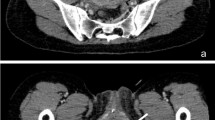Abstract
Purpose
Since vaginal meshes in pelvic organ prolapse have been associated with more complications in the last decades, native tissue vaginal repair is still the mainstay of prolapse surgery. This study introduces a new transvaginal approach with bilateral sacrospinous ligament fixation augmented by autologous rectus fascia graft to repair high-stage apical vaginal wall prolapse.
Methods
Between December 2018 and June 2020, 13 patients with high-stage apical vaginal wall prolapse (point C ≥ + 1) accompanied by high-stage anterior vaginal wall prolapse (paint Ba ≥ + 1) were included. In this procedure, the central part of the anterior rectus fascia graft (6–8 cm in length and 1–1.5 cm in width) is sutured to the underlying tissue of the vaginal apex or cervix and the arms of the rectus graft augmented to the sacrospinous ligament with a Capio suture capturing device (Boston Scientific). The patients are evaluated by history taking, physical examination, Pelvic Floor Impact Questionnaire (PFIQ-7), and Pelvic Floor Distress Inventory (PFDI-20) Questionnaire.
Results
The patient’s mean age was 61.2 ± 2.7 years and they were followed up to 12 months. The anatomical success rate was 92.3%. The PFDI-20 and PFIQ-7 were significantly improved (P < 0.001). There were no significant perioperative complications. Three patients complained of unilateral groin or buttock pain which resolved gradually at the first post-operative month.
Conclusion
The transvaginal bilateral sacrospinous ligament fixation augmented by autologous rectus fascia graft is an effective and safe surgical approach in treating high-stage apical vaginal prolapse with short-term follow-up.





Similar content being viewed by others
References
Lemack GE, Carmel M (2020) Campbell Walsh Wein Urology. E-Book Elsevier Health Sciences, Netherlands
Braga A, Serati M, Salvatore S, Torella M, Pasqualetti R, Papadia A et al (2020) Update in native tissue vaginal vault prolapse repair. Int Urogynecol J 31:2003–2010
Paz-Levy D, Yohay D, Neymeyer J, Hizkiyahu R, Weintraub AY (2017) Native tissue repair for central compartment prolapse: a narrative review. Int Urogynecol J 28:181–189
Elliott CS, Yeh J, Comiter CV, Chen B, Sokol ER (2013) The predictive value of a cystocele for concomitant vaginal apical prolapse. J Urol 189:200–203
Murphy AM, Clark CB, Denisenko AA, D’Amico MJ, Vasavada SP (2021) Surgical management of vaginal prolapse: current surgical concepts. Can J Urol 28:22–26
Zhang W, Cheon WC, Zhang L, Wang X, Wei Y, Lyu C (2022) Comparison of the effectiveness of sacrospinous ligament fixation and sacrocolpopexy: a meta-analysis. Int Urogynecol J 33:3–13
Skoczylas LC, Turner LC, Wang L, Winger DG, Shepherd JP (2014) Changes in prolapse surgery trends relative to FDA notifications regarding vaginal mesh. Int Urogynecol J 25:471–477
Makajeva J, Watters C, Safioleas P (2022) Cystocele. In: StatPearls. StatPearls Publishing Copyright © 2022, StatPearls Publishing LLC, Treasure Island (FL). PMID: 33231973. Bookshelf ID: NBK564303
Sun ZJ, Guo T, Wang XQ, Lang JH, Xu T, Zhu L (2021) Current situation of complications related to reconstructive surgery for pelvic organ prolapse: a multicenter study. Int Urogynecol J 32:2149–2157
Bump RC, Mattiasson A, Bø K, Brubaker LP, DeLancey JO, Klarskov P et al (1996) The standardization of terminology of female pelvic organ prolapse and pelvic floor dysfunction. Am J Obstet Gynecol 175:10–17
Tibi B, Vincens E, Durand M, Bentellis I, Salet-Lizee D, Kane A et al (2019) Comparison of different surgical techniques for pelvic floor repair in elderly women: a multi-institutional study. Arch Gynecol Obstet 299:1007–1013
Pollak J, Takacs P, Medina C (2007) Complications of three sacrospinous ligament fixation techniques. Int J Gynecol Obstet 99:18–22
Sederl J (1958) Surgery in prolapse of a blind-end vagina. Geburtshilfe Frauenheilkd 18:824–828
Miyazaki FS (1987) Miya Hook ligature carrier for sacrospinous ligament suspension. Obstet Gynecol 70:286–288
Shull BL (1999) Pelvic organ prolapse: anterior, superior, and posterior vaginal segment defects. Am J Obstet Gynecol 181:6–11
Culligan PJ, Blackwell L, Goldsmith LJ, Graham CA, Rogers A, Heit MH (2005) A randomized controlled trial comparing fascia lata and synthetic mesh for sacral colpopexy. Obstet Gynecol 106:29–37
Culligan PJ, Salamon C, Priestley JL, Shariati A (2013) Porcine dermis compared with polypropylene mesh for laparoscopic sacrocolpopexy: a randomized controlled trial. Obstet Gynecol 121:143–151
Barber MD, Brubaker L, Nygaard I, Wheeler TL 2nd, Schaffer J, Chen Z et al (2009) Defining success after surgery for pelvic organ prolapse. Obstet Gynecol 114:600–609
Palmerola R, Rosenblum N (2019) Prolapse repair using non-synthetic material: what is the current standard? Curr Urol Rep 20:70
Giannini A, Caretto M, Russo E, Mannella P, Simoncini T (2019) Advances in surgical strategies for prolapse. Climacteric 22:60–64
Jelovsek JE, Barber MD, Brubaker L, Norton P, Gantz M, Richter HE et al (2018) Effect of uterosacral ligament suspension vs sacrospinous ligament fixation with or without perioperative behavioral therapy for pelvic organ vaginal prolapse on surgical outcomes and prolapse symptoms at 5 years in the OPTIMAL randomized clinical trial. JAMA 319:1554–1565
Funding
The author certifies that she has no affiliations with or involvement in any organization or entity with any financial or non-financial interest in the subject matter or materials discussed in this manuscript. In addition, the author did not receive support from any organization for the submitted work.
Author information
Authors and Affiliations
Corresponding author
Ethics declarations
Conflicts of interest
The author has nothing to disclose.
Additional information
Publisher's Note
Springer Nature remains neutral with regard to jurisdictional claims in published maps and institutional affiliations.
Rights and permissions
About this article
Cite this article
Sharifiaghdas, F. Autologous rectus fascia graft in the treatment of high-stage apical vaginal prolapse: preliminary results of a new surgical approach with native tissue. Int Urol Nephrol 54, 1017–1022 (2022). https://doi.org/10.1007/s11255-022-03167-8
Received:
Accepted:
Published:
Issue Date:
DOI: https://doi.org/10.1007/s11255-022-03167-8




